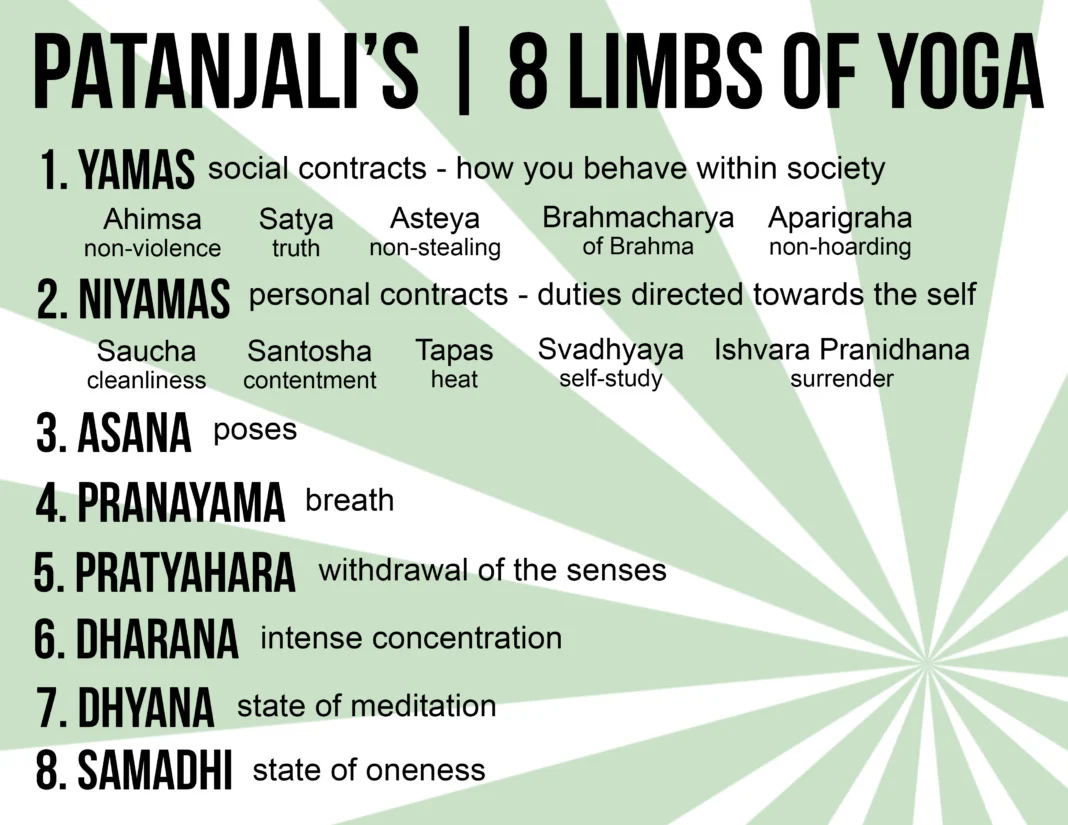
What are the 8 Limbs of Yoga?
Yoga is an ancient practice dating back to the Vedic period (1500 BC). Throughout the years, and especially in our modern world, people have started to create their own styles and methods, but one thing remains true throughout all the iterations…that there are eight different aspects, or limbs, of yoga that are indoctrinated within all these variations of yoga. In the western world, we most often think of yoga in a classroom setting with students moving through poses on a mat, known as yoga asana. That common perception of yoga is asana, and it is actually just one limb of the eight-limbed yoga path.
The sage Patanjali outlined the eight limbs of yoga as a path toward enlightenment, or bliss (samadhi). Each of the eight limbs of yoga has a purpose that guides you into a journey of bliss. In this post, we will go through the 8 Limbs of Yoga briefly.
1. Yamas
Yamas are rules for your behavior toward others and all living beings in the world around you. They are the social contracts you have with society. There are five yamas or restraints:
- Ahimsa, or non-violence, includes physical, mental, and emotional non-violence toward all living things (including yourself!). Letting go of negativity and hurt will create more space for love and kindness.
- Satya, or truthfulness, refers to speaking and acting from the truth. Be careful not to confuse your opinions and beliefs with what is the truth. This requires us to carefully consider what we say and refrain from saying. Practicing Satya will cultivate integrity and respect.
- Asteya, or non-stealing, refers to refraining from the theft of material objects, and also includes non-tangible objects as well. Non-tangible things include other’s energy, joy, and time.
- Bramacharya, or moderation, is the practice of maintaining control over our physical and mental impulses. Through this act of restraint, we can attain higher levels of energy and happiness by purposefully consuming exactly what we need in that moment. Traditionally this was interpreted as celibacy but can also include excess food, drink, work, sleep, or anything that can be taken in excess that would throw your life out of balance.
- Aparigraha, or non-coveting, is the ability to let go of greed and possessiveness. This includes material possessions, but also personal beliefs that no longer serve us. By releasing our attachment to these thoughts and things, we open up internal and mental space for more positive energy and progress.
2. Niyamas
Niyamas are personal contracts or rules for your behavior toward yourself. There are five Niyamas or observances:
- Saucha, or cleanliness, can be physical, mental, and emotional. Saucha is physical and mental hygiene. Keep your body and your environment clean. This includes your home, workstation, and car.
- Santosha, or contentment, is the practice of accepting and appreciating what we already have. It is the underlying joy within all of us that cannot be shaken by life’s obstacles.
- Tapas, literally translates into “generating heat.” Tapas teaches us to create and harness a fire within ourselves. The fire acts like motivation and drive for us to use as fuel to continue bettering ourselves.
- Svadhyaya, or self-study, is the journey you take towards self-realization. This is the journey to becoming your truest self.
- Ishvara Pranidhana, or dedication to the highest entity, is the understanding that we are all a part of a “divine matrix.” This can mean different things to different people, but regardless of your personal belief, it is the acceptance and understanding that we are all part of something greater than ourselves.
3. Asana
This is the physical practice of yoga that we know as yoga postures. It’s what we do when we go to a yoga class at the gym or studio. Initially asana translated to a “seat.” Eventually, asana became a variety of yoga poses and now serves as a way to exhaust the body and prepare it for seated meditation for an extended period of time. The movement of asana is also a way to create ease and space in the body, which leads to ease and space in the mind.
4. Pranayama
Prana is life force, breath and energy. Yama is control. Pranayama thus means “breath control.” In a yoga class, you may hear a teacher setting students up for Ujjayi breathe, which is a form of pranayama. There are many forms of breath with different purposes, to increase heat, cool the body, to maintain awareness. By gaining mastery over our breath, we can use breath to rejuvenate the body and discipline our awareness.
5. Pratyahara
The fifth limb describes withdrawal or mastery over the senses. Pratyahara requires us to withdraw from the stimuli of the outside world in order to turn into the self and be aware of our inner voice. This step prepares the mind for meditation. It can also be used throughout your day to help you filter out the noise and negativity that does not serve you.
6. Dharana
Once we have withdrawn from the outside stimuli through the practice of pratyahara, we are ready to practice dharana. Dharana means “concentrated focus.” What this means is withdrawing from the stimuli of your mind and thoughts. We do this by focusing on a single image, word, or mantra. In this process, we practice concentration with our minds as a step toward meditation.
You will know dharana is at work when you set an intention and maintain it through class. Dharana can also be applied beyond a yoga class on decisions such as career, love, and friendships.
7. Dhyana
Dhyana is meditation, or an uninterrupted flow of concentration. Where dharana uses extended focus on an object as a tool to calm the mind, dhyana is the act of being keenly aware yet without focus. The mind is quiet and is producing little to no thoughts. When we have achieved dhyana, we are able to stay centered amidst change, challenge, and distraction.
8. Samadhi
The eighth and final limb of yoga is enlightenment, self-realization and bliss. Samadhi is the moment where you transcend the self and realize a connection with the divine and with all living things, a sense of oneness. You feel the interconnectedness between everything that exists around you and within you. This process of self-actualization allows us to become our truest and most authentic selves.
Samadhi can be fleeting and brief, but that makes it all the more important to practice the 8 limbed path regularly. It is a reminder that change is inevitable.
Pin this!

Thank you for visiting today! If you found this encouraging or informative, please connect with us on Instagram or TikTok. Sign up for our monthly newsletter for updates and more. We promise we won't spam you! Feel free to unsubscribe anytime. If you're a brand and want to work with us, please visit this page to get in touch.


Jacquelyn Wheeler
Tuesday 10th of August 2021
Great, quick resource! Thanks for sharing :)